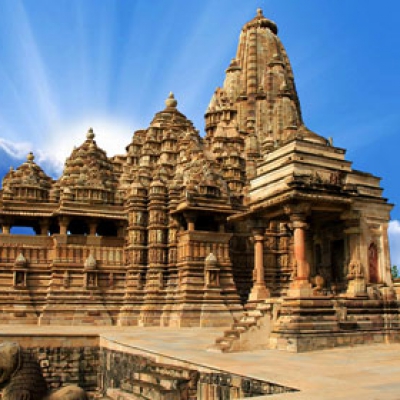
Khajuraho Temple
Khajuraho is a fabled heritage city in Madhya Pradesh which is internationally recognized for the opulent architectural grandeur of its group of temples, acknowledged and protected as UNESCO World Heritage Sites. These extraordinary temples, meticulously crafted from fine sandstone, exemplify the Nagara and Dravidian style of architecture and are especially noted for their intricate stone carvings featuring human and animal forms in erotic poses.
Khajuraho Temple - Madhya Pradesh - North India
Speciality
Khajuraho once served as the cultural capital of the Chandela Rajput clan, who governed this region from the 10th to the 12th centuries. During their reign, Khajuraho was adorned with about 85 temples, scattered over a 20-square-kilometer expanse. However, only 20 of these temples have endured the test of time to constitute one of the world's most exceptional artistic wonders.
Khajuraho's marvellous temples are sure to captivate both tourists and art enthusiasts with their grandeur and abundant sculptural treasures. The most iconic aspect of Khajuraho Temples is the sensual sculptures that embellish the temple facades. These erotic sculptures have often led to speculation and debate regarding their significance, but they remain a unique and defining feature of Khajuraho. Beyond their sensuous nature, Khajuraho's sculptural wonders offer a window into the lives of Indians from a bygone era. The temple architecture also beautifully narrates tales of royalty, courtship, marriage, spiritual teachings, meditation, kinship, and the intricacies of human emotions and relationships.
Exploring Khajuraho is a once-in-a-lifetime experience, a journey back in time to an era defined by art, culture, and spirituality.
History of Khajuraho Temple?
The Khajuraho temples were built during the rule of the Chandela dynasty. All the three temple monuments were constructed in the 10th century simultaneously. Historians state that these temple monuments depicts the respect and tolerance different religions have for each other
Entry/Darshan Time:
The temples are open from visiting from 8.00 am to 6.00 pm.
Dress Code:
No specific dress code is recommended for a visit to this temple. Still, costumes covering upper arms and legs are suggested as a mark of respect to the temple customs.
Festivals
The Khajuraho Dance festival happens at the site of the Khajuraho temples in the background
Major Attractions:
- Kandariya Mahadeva Temple.
- Lakshmana Temple.
- Panna National Park.
- Manjeshwar Temple.
- Javari Temple.
- Chaturbhuj Temple.
- Vishvanatha Temple.
- Jagadambi Temple.
- Shantinatha Temple.
- State Museum Of Tribal and Folk Art.
- Duladeo Temple.
- Parsvnath Temple.
- Archaeological Museum Khajuraho.
- Raneh Falls.
- Beni Sagar Dam.
- Dhubela Museum.
- Jain Museum.
- Nandi Temple.
- Chausath Yogini Temple.
- Adinath Temple.
- Varaha Temple.
- Vaman Temple.
- Chitragupta Temple.
- Ghantai Temple.
- Kalinjar Fort.
Climatic Condition:
Khajuraho features a subtropical climate characterized by hot summers and cool winters. Summers, from March to June, can be scorching with temperatures exceeding 40°C, so it's best to explore the temples in the early mornings or late evenings. The weather is pleasant during the winter season (October to March) with temperatures ranging from 10°C to 27°C, making it ideal for exploring the temples and engaging in outdoor activities. The monsoon season, from July to September, brings moderate rainfall, resulting in lush green surroundings, but heavy rains can disrupt travel plans.
Best time to visit:
October to March.
Things to Do:
- Temple Visit.
- Attend the Sound & Light Show.
- Sightseeing.
- Shopping.
- Photography.
How to reach:
By Air:Khajuraho Airport is the nearest airport which is well-connected to major Indian cities like Delhi, Varanasi, Agra, Bhopal, etc. Buses and cabs are easily available from the airport to Khajuraho.
By Train:Khajuraho Railway Station is the nearest railway station to Khajuraho. Buses and cabs are easily available from the railway station to Khajuraho.
By Road:You can reach Khajuraho by road through a well-maintained network of highways.
FAQ:
1.What Makes Khajuraho Temples Unique?
The Khajuraho temples are noted for their intricate and exquisite erotic sculptures that adorn their facades. These sculptures are a celebration of human passion, love, and the art of lovemaking and are considered some of the most artistic and sensuous depictions in the world of temple architecture. Although these sculptures constitute a noticeable aspect of the temples, they make up only a small portion of the overall temple artwork, which also comprises representations of deities, everyday life, and mythological tales.
2.How Many Temples Are There In Khajuraho?
There were originally 85 temples in Khajuraho, out of which only 20 still remain.
3.Are The Temples of Khajuraho Still Active For Worship?
Among all the temples in Khajuraho, the Matangeshvara temple is the only temple that is still active for worship today.
4.Is Photography Allowed At The Khajuraho Temples?
Photography is permitted at the Khajuraho Temples, but there are specific guidelines to follow. Inside the temples, the use of flash photography is not allowed, and there might be limitations on the use of tripods, drone cameras, or other photography equipment.